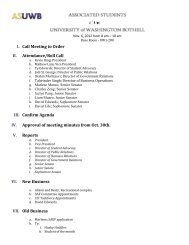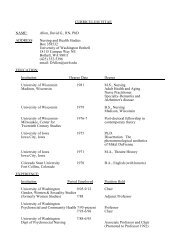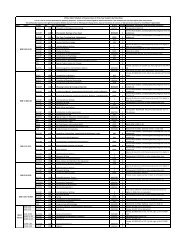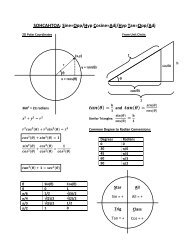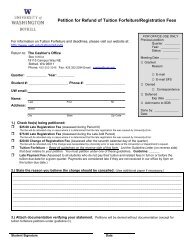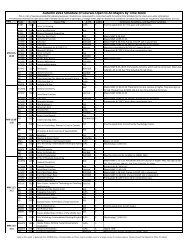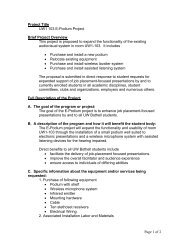In Situ Data Provenance Capture in Spreadsheets
In Situ - UW Bothell
In Situ - UW Bothell
- No tags were found...
Create successful ePaper yourself
Turn your PDF publications into a flip-book with our unique Google optimized e-Paper software.
Figure 4. Filtered provenance log accord<strong>in</strong>g to the Field column (column B). We leverage Excel’s built-<strong>in</strong> filter capabilities to enhance provenance analysis.<br />
corresponds to the attribute name <strong>in</strong> the dataset, the user can<br />
easily locate the specified attributes.<br />
4) Use Case 4: What can I do to view the <strong>in</strong>correct<br />
process<strong>in</strong>g I may have done?<br />
This can be accomplished by stepp<strong>in</strong>g through the changes<br />
us<strong>in</strong>g the dynamic version<strong>in</strong>g <strong>in</strong> the system. Assume that we<br />
want to step through the changes accord<strong>in</strong>g to task. Let us<br />
create the number of versions accord<strong>in</strong>g to the number of tasks<br />
<strong>in</strong> our log (4 <strong>in</strong> this example). These versions can be<br />
represented <strong>in</strong> columns H, I, J, K. We assign a version for each<br />
task, denoted by “Y” <strong>in</strong> Figure 2. When we go back to our<br />
data, we can step through our process<strong>in</strong>g by enter<strong>in</strong>g the<br />
appropriate column version <strong>in</strong> the “Version to Run” field <strong>in</strong> the<br />
ribbon menu. Do<strong>in</strong>g so highlights the changes for the <strong>in</strong>dicated<br />
version (see Figure 5). <strong>In</strong> addition, one can also view changes<br />
made at the action level or at both task and action levels.<br />
B. User Evaluation<br />
<strong>In</strong> addition to simulat<strong>in</strong>g use cases on the tool, we also<br />
asked a research member of the Jaffe Atmospheric Research<br />
group at UWB to use our Excel Add-<strong>In</strong> tool dur<strong>in</strong>g actual data<br />
process<strong>in</strong>g sessions. The task entailed process<strong>in</strong>g a raw dataset<br />
to transform it <strong>in</strong>to a format that can be analyzed by researchers<br />
<strong>in</strong> the group. The steps followed <strong>in</strong>clude check<strong>in</strong>g the data,<br />
correct<strong>in</strong>g entries, and us<strong>in</strong>g statistical formulas. The user,<br />
who is <strong>in</strong> charge of manag<strong>in</strong>g the data for the group, used our<br />
tool to capture his process<strong>in</strong>g on a raw dataset with 26,500<br />
rows and 30 columns, which is a typical dataset size <strong>in</strong> his<br />
group.<br />
Accord<strong>in</strong>g to the user, the tool was effective <strong>in</strong> captur<strong>in</strong>g<br />
his changes and also allowed him to easily revert to a previous<br />
version when needed. He stated that the tool answers a key<br />
provenance question for the research group: “What changed<br />
from the older version to the newer version of the dataset?”<br />
The ability to track f<strong>in</strong>e-gra<strong>in</strong>ed changes was also helpful as it<br />
helped him to quickly recall his data process<strong>in</strong>g steps. <strong>In</strong> terms<br />
of efficiency, the provenance capture tool allowed him to save<br />
approximately 20-30 m<strong>in</strong>utes per file.<br />
The provenance log was also beneficial to the user. <strong>In</strong><br />
particular, the user found the group<strong>in</strong>g of actions <strong>in</strong>to highlevel<br />
tasks to be helpful <strong>in</strong> understand<strong>in</strong>g the log. <strong>In</strong> addition,<br />
the placement of the provenance log with<strong>in</strong> the file was a<br />
benefit to him, as “only need<strong>in</strong>g one file is a bonus and saves<br />
on disk space.”<br />
The user did suggest some tool improvements. He would<br />
like to have a comment box so that he can enter miscellaneous<br />
notes and keep track of the rationale for his process<strong>in</strong>g steps.<br />
<strong>In</strong> addition, he would prefer to have f<strong>in</strong>er-gra<strong>in</strong>ed dist<strong>in</strong>ctions<br />
for content changes. <strong>Data</strong> entry, data correction, and formula<br />
entries were all labeled as “CellsChanged” <strong>in</strong> the log, which<br />
was <strong>in</strong>itially confus<strong>in</strong>g to him.<br />
It took the user, who has programm<strong>in</strong>g experience, about 20<br />
m<strong>in</strong>utes to learn the tool after see<strong>in</strong>g a demo of how it is used.<br />
C. Discussion<br />
The user feedback we obta<strong>in</strong>ed regard<strong>in</strong>g the tool suggests<br />
that <strong>in</strong>ternal provenance support with<strong>in</strong> an off-the-shelf<br />
analysis tool like Excel has utility. While there are requests for<br />
tool improvements, the user has expressed enthusiasm at the<br />
prospect of regularly us<strong>in</strong>g the tool dur<strong>in</strong>g his data process<strong>in</strong>g.<br />
S<strong>in</strong>ce the user has programm<strong>in</strong>g experience, he may be<br />
favorably biased towards us<strong>in</strong>g new tools for his work.<br />
However, with the data process<strong>in</strong>g workload he handles for the<br />
group, it seems unlikely that he will adopt a new tool unless he<br />
sees concrete benefits <strong>in</strong> us<strong>in</strong>g the tool. One advantage of our<br />
approach is that we leverage the user’s exist<strong>in</strong>g knowledge of<br />
Excel to lower the barrier to entry <strong>in</strong> us<strong>in</strong>g the tool. Another<br />
advantage is that our tool operates <strong>in</strong> the background <strong>in</strong> an<br />
unobtrusive manner; thus, the user’s normal work rout<strong>in</strong>es are<br />
not significantly altered.<br />
It would be useful to conduct further evaluations on users<br />
with varied technical expertise. Moreover, f<strong>in</strong>e-gra<strong>in</strong>ed<br />
version<strong>in</strong>g could benefit from further test<strong>in</strong>g, especially<br />
<strong>in</strong>volv<strong>in</strong>g the <strong>in</strong>teractions between structural changes (e.g.<br />
<strong>in</strong>sert/delete columns). Nonetheless, this evaluation suggests<br />
that our provenance framework has utility and can save users a<br />
substantial amount of time.



